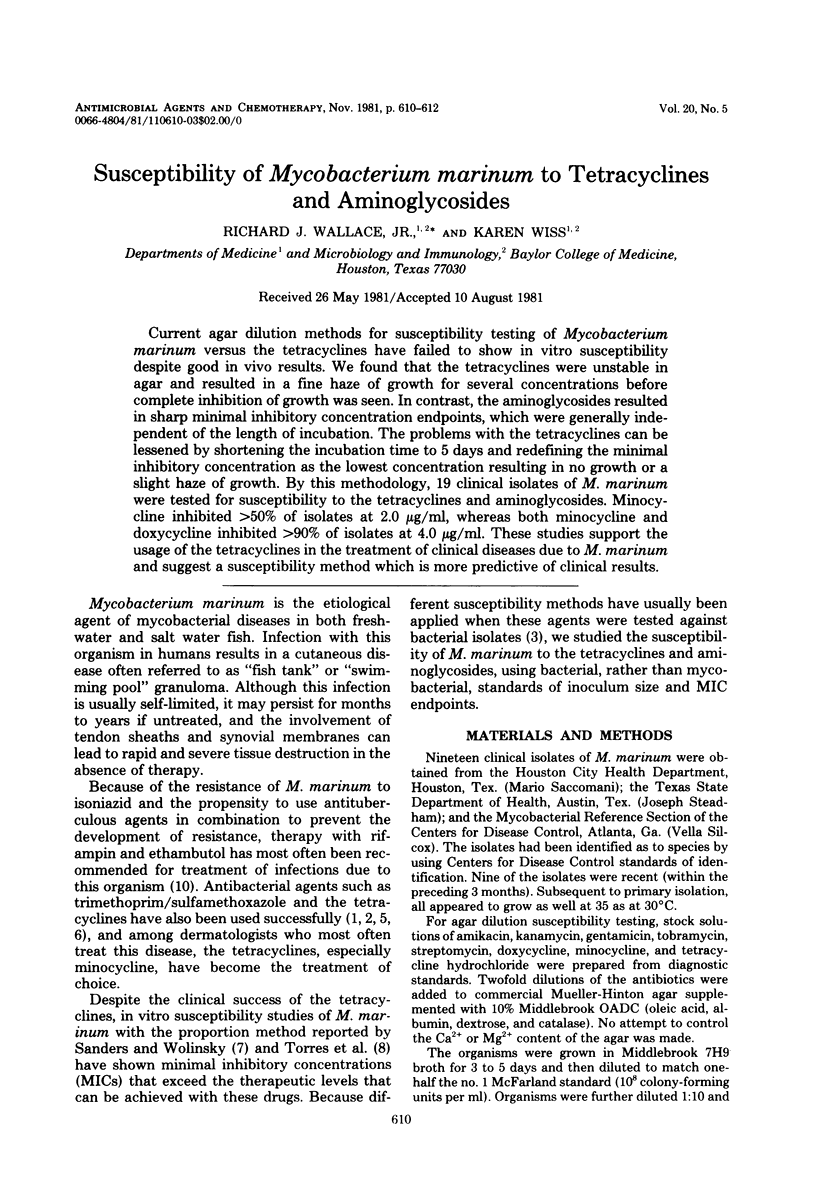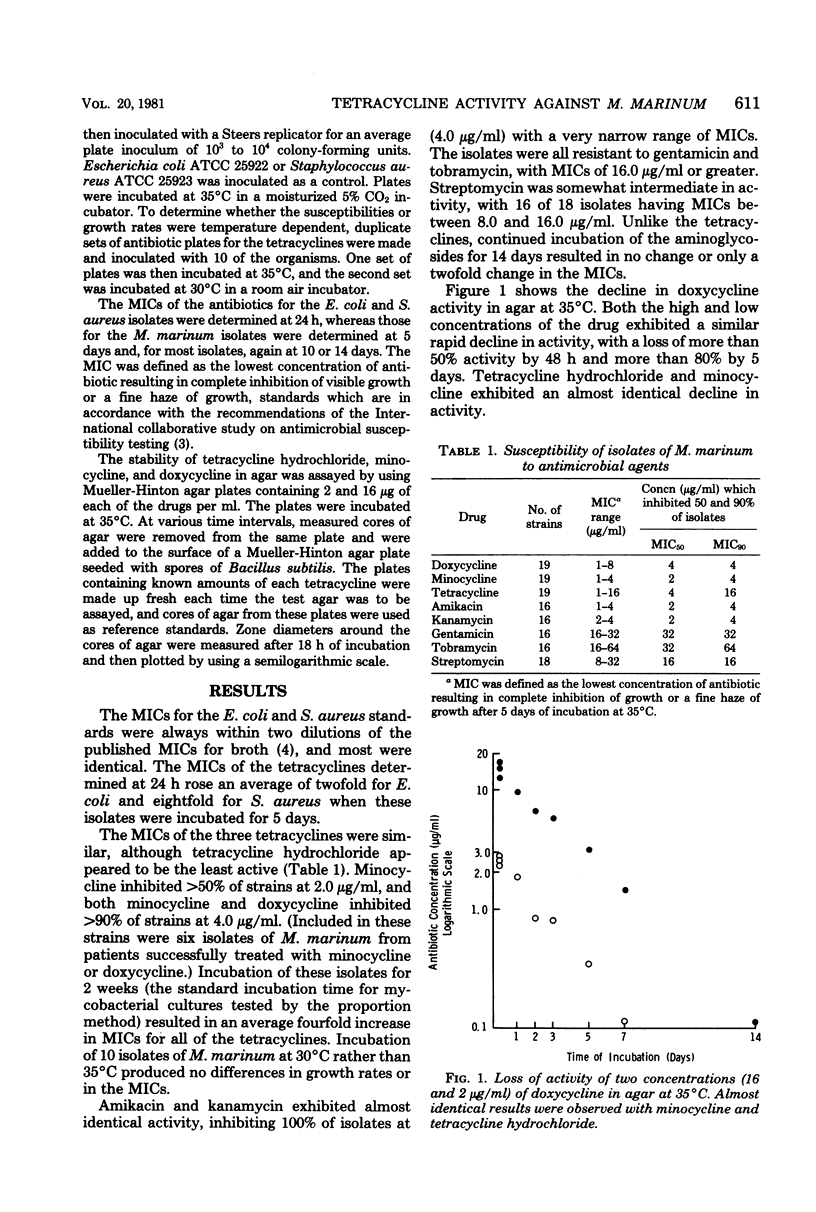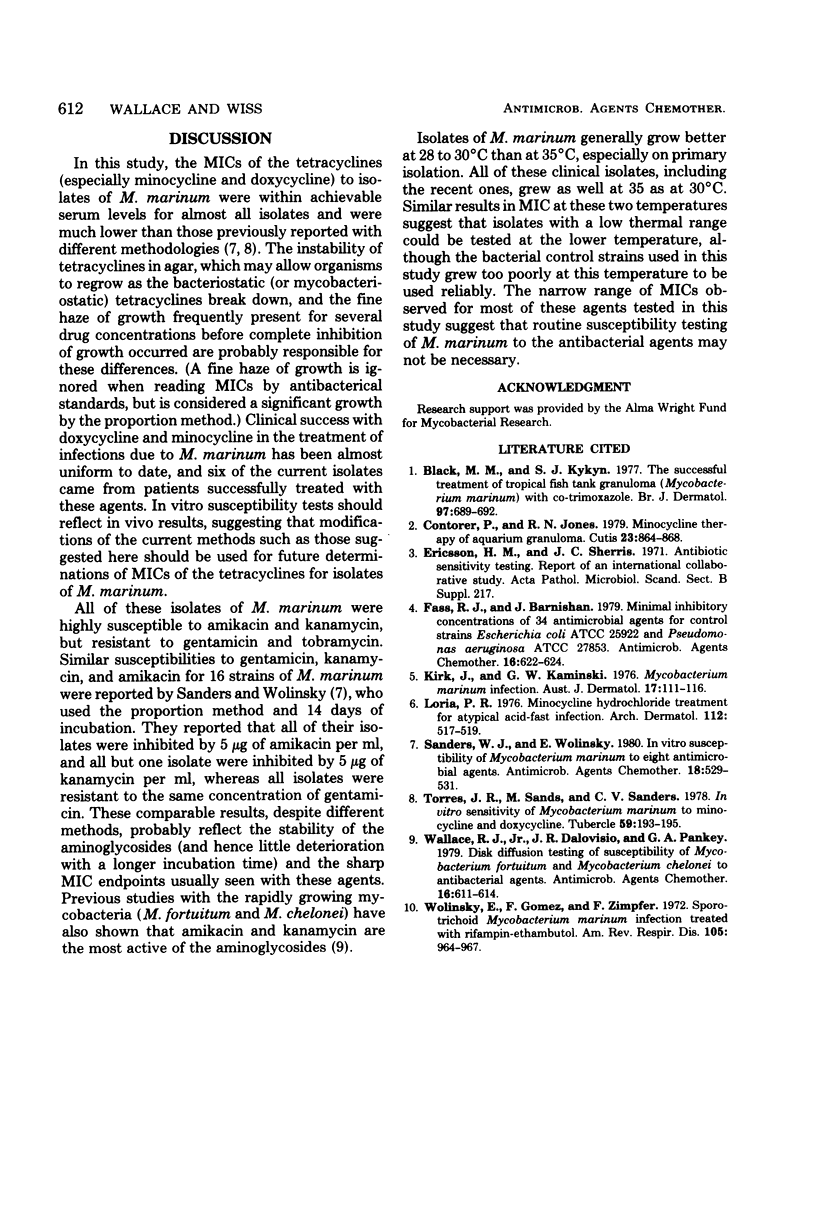Abstract
Current agar dilution methods for susceptibility testing of Mycobacterium marinum versus the tetracyclines have failed to show in vitro susceptibility despite good in vivo results. We found that the tetracyclines were unstable in agar and resulted in a fine haze of growth for several concentrations before complete inhibition of growth was seen. In contrast, the aminoglycosides resulted in sharp minimal inhibitory concentration endpoints, which were generally independent of the length of incubation. The problems with the tetracyclines can be lessened by shortening the incubation time to 5 days and redefining the minimal inhibitory concentration as the lowest concentration resulting in no growth or a slight haze of growth. By this methodology, 19 clinical isolates of M. marinum were tested for susceptibility to the tetracyclines and aminoglycosides. Minocycline inhibited greater than 50% of isolates at 2.0 microgram/ml, whereas both minocycline and doxycycline inhibited greater than 90% of isolates at 4.0 microgram/ml. These studies support the usage of the tetracyclines in the treatment of clinical diseases due to M. marinum and suggest a susceptibility method which is more predictive of clinical results.
Full text
PDF


Selected References
These references are in PubMed. This may not be the complete list of references from this article.
- Black M. M., Eykyn S. J. The successful treatment of tropical fish tank granuloma (Mycobacterium marinum) with co-trimoxazole. Br J Dermatol. 1977 Dec;97(6):689–692. doi: 10.1111/j.1365-2133.1977.tb14279.x. [DOI] [PubMed] [Google Scholar]
- Contorer P., Jones R. N. Minocycline therapy of aquarium granuloma. Case reports and literature review. Cutis. 1979 Jun;23(6):864–868. [PubMed] [Google Scholar]
- Ericsson H. M., Sherris J. C. Antibiotic sensitivity testing. Report of an international collaborative study. Acta Pathol Microbiol Scand B Microbiol Immunol. 1971;217(Suppl):1+–1+. [PubMed] [Google Scholar]
- Fass R. J., Barnishan J. Minimal inhibitory concentrations of 34 antimicrobial agents for control strains Escherichia coli ATCC 25922 and Pseudomonas aeruginosa ATCC 27853. Antimicrob Agents Chemother. 1979 Nov;16(5):622–624. doi: 10.1128/aac.16.5.622. [DOI] [PMC free article] [PubMed] [Google Scholar]
- Kirk J., Kaminski G. W. Mycobacterium marinum infection. Australas J Dermatol. 1976 Dec;17(3):111–116. doi: 10.1111/j.1440-0960.1976.tb00802.x. [DOI] [PubMed] [Google Scholar]
- Loria P. R. Minocycline hydrochloride treatment for atypical acid-fast infection. Arch Dermatol. 1976 Apr;112(4):517–519. [PubMed] [Google Scholar]
- Sanders W. J., Wolinsky E. In vitro susceptibility of Mycobacterium marinum to eight antimicrobial agents. Antimicrob Agents Chemother. 1980 Oct;18(4):529–531. doi: 10.1128/aac.18.4.529. [DOI] [PMC free article] [PubMed] [Google Scholar]
- Torres J. R., Sands M., Sanders C. V. In vitro sensitivity of Mycobacterium marinum to minocycline and doxycycline. Tubercle. 1978 Sep;59(3):193–195. doi: 10.1016/0041-3879(78)90026-0. [DOI] [PubMed] [Google Scholar]
- Wallace R. J., Jr, Dalovisio J. R., Pankey G. A. Disk diffusion testing of susceptibility of Mycobacterium fortuitum and Mycobacterium chelonei to antibacterial agents. Antimicrob Agents Chemother. 1979 Nov;16(5):611–614. doi: 10.1128/aac.16.5.611. [DOI] [PMC free article] [PubMed] [Google Scholar]
- Wolinsky E., Gomez F., Zimpfer F. Sporotrichoid Mycobacterium marinum infection treated with rifampin-ethambutol. Am Rev Respir Dis. 1972 Jun;105(6):964–967. doi: 10.1164/arrd.1972.105.6.964. [DOI] [PubMed] [Google Scholar]


